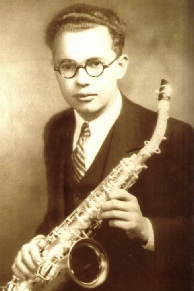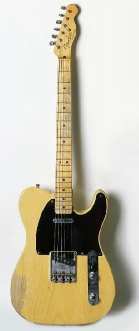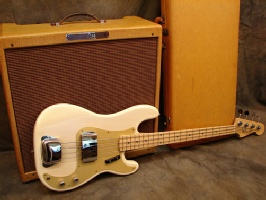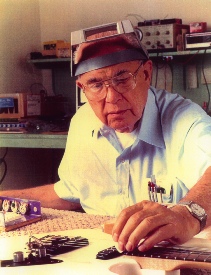


Fender Guitar History
Leo Fender has been honored by induction into both The Rock and Roll and Country Music Hall Of Fame. Leo Fender didn’t invent the solid body electric guitar. He didn’t invent the electrical bass guitar. He didn’t invent the magnetic pickup. What Leo Fender did do was use Henry Ford’s assembly line technique of mass produced interchangeable parts to successfully design, build and market high quality innovative solid body electric guitars and amplifiers. Quality guitars that were affordable, durable, easy to hold, easy to tune, easy to repair and easy to play. Guitars that would play a pivotal role in the evolution of the music

industry.
Leo Fender; The Early Years
According to Leo Fender, he was born on August 10, 1909 in a barn. A barn that his family was sharing with the horses on their property in Orange County, California. Although he studied the piano and saxophone during his early years, Leo often was quoted as saying he couldn’t play one note of music on a guitar. He was an electronics technician and an inventor, not a musician. It was electronics that caught Leo’s attention. Self taught, he started building and repairing radios while in high school.
Leo Fender graduated from Fullerton Union High School in 1928 and entered junior college, not as an electronics major, but as an accounting major. While in college, he continued his work
on radios as a hobby. After college, Leo went to work as a book keeper for a cold storage company in Anaheim, California. During this time period, Leo designed and built P. A. systems for local dance bands.
In 1934, Leo Fender married Esther Klosky. They moved to San Luis Obispo, California where he went to work for The California Highway Department as an accountant. Because of the depressed economy at the time, Leo’s job was eliminated and he was out of work. He went to work as an accountant for a local tire company, but after six months, he was out of work again.
Leo Fender moved back to Fullerton in 1938 and with borrowed money opened Fender Radio Service. Fender Radio Service sold records and also repaired radios, phonographs, musical instrument amplifiers and P. A. systems. Because of the requests of band leaders and musicians, he began to design and build custom amplifiers and P. A. systems. He also developed a successful rental program for P. A. Systems.
In 1945, Leo Fender started K and F Manufacturing Company. His partner in the venture was former Rickenbacker Guitar Company employee and musician Clayton “DOC” Kaufman. K and F built amplifiers and lap steel guitars. During this period Leo and Doc received patents for a lap steel guitar and an electrical guitar pickup.
The music scene changed dramatically after World War II. Big Band music gave way to rhythm and blues, boogie woogie and country swing. Big Bands were replaced by small combos and the road houses, dance halls and honkey


tonks were born. The demand for lap steel guitars diminished. Leo Fender recognized the marketing potential for a Spanish style electric guitar that not only provided accurate intonation and prevented feedback at loud volumes, but was affordable, repairable and rugged.
The Fender Telecaster
In 1946, Leo Fender and successful businessman F.C. Hall formed the Fender Electric Instrument Company in Fullerton, California and began designing a solid body guitar with a replaceable bolt on neck. The finished product, the Fender Broadcaster, was released in January, 1951. Fender sold 87 of them immediately. The name Broadcaster was legally challenged on trademark infringement by the Gretsch Company, who had marketed a drum set named Broadkaster since 1935. On February 21, 1951 the Broadcaster officially became the Telecaster.
Leo Fender Enters The Music Industry

bass guitar. It was easy to transport, did not produce feedback at high amplified volumes and the fretted bolt on neck with a 34 inch scale made it easy to play. The Precision Bass had such a profound effect on the music world that for quite a few years after it was released any electric bass guitar was referred to as a Fender Bass. Along with the Precision Bass, Fender also introduced a 45 watt bass amplifier with four 10 inch speakers.
The Fender Precision Bass
Also in 1951, Leo Fender and Fender Guitars employee George Fullerton completed development of the first mass produced solid body electric
The Fender Precision Bass guitar and the matching Fender Bassman amplifier changed the face of popular music forever. Today, 60 years after its debut, the Precision Bass is still one of the best selling electric bass guitars on the market.


In 1953, F.C. Hall sold his interest in The Fender Electric Instrument Company to Leo Fender. Hall then purchased the Electro String Instrument Company from Adolph Rickenbacker and the modern era of Rickenbacker Guitars was born. At that time, Leo acquired sole ownership of The Fender Electric Instrument Company.
The Fender Stratocaster
The success and popularity of the Telecaster convinced Leo Fender to go back to the drawing board and in 1954 the Stratocaster was unveiled to the public. Created by Leo Fender and draftsman Freddie Tavares, the Stratocaster featured a double cutaway contoured body, a third single coil pickup, a rounder neck profile and the newly developed Fender vibrato bridge. The Stratocaster quickly found its place in history and is still in production today.
Industrial engineer Forrest White was hired by Leo Fender as plant manager on May 20, 1954. White brought much needed oversight and organization to the company. Many people credit Fender’s financial success with White’s production techniques. It was during this time period that the Jazzmaster and Jaguar guitars were brought to market. Both of these guitars featured advanced volume controls and pickup selection switches with a bright warm tone. Although not well received at the time of their release, both designs became immensely popular with the Surf Rock crowd a few years later.
The Fender Jazz Bass
The Fender Jazz Bass guitar was introduced in 1960. Leo Fender designed the Jazz Bass to have a mellower tone than the Precision Bass. Its body was made of alder instead of ash and had two pickups. Like the Precision Bass, the Jazz Bass used a 34 inch scale, but had a narrower tapered fingerboard. The Jazz Bass was hugely successful and is still popular today.
Music Man Instrument Company.
Although he suffered a series of strokes, Leo Fender continued to design guitars and basses. In 1976, Leo designed the Sting Ray, the first production bass guitar with active electronics. The Sting Ray was a commercial success and in 1979 Leo teamed up with longtime friends Dale Hyatt and George Fullerton to form G & L Musical Products. G & L set up shop on Fender Avenue in Fullerton. It is a popular opinion that the guitars G & L manufactured were of higher quality than the pre C B S Fenders. During his time with G & L, Leo Fender was granted new patents for neck construction, vibrato systems and single coil pickups.

When Leo Fender died on March 21, 1991 a part of America died with him. Leo was the epitome of The American Spirit. He was a self taught electronic technician, inventor and entrepreneur. Leo Fender’s contributions to the music industry have been honored by induction into BOTH the Rock and Roll Hall of Fame and the Country Music Hall of Fame. That in itself is quite a feat, considering that he never learned to play the guitar. Described as a friendly, modest man, Leo Fender was well respected by those who knew and worked with him. His innovative electric guitars and amplifiers live on and he lives on through his instruments.
Leo Fender; The Final Years
In 1965, Leo Fender became seriously ill with Parkinson’s disease and sold the Fender
Electric Instrument Company to C B S Musical Instruments. C B S required a non-